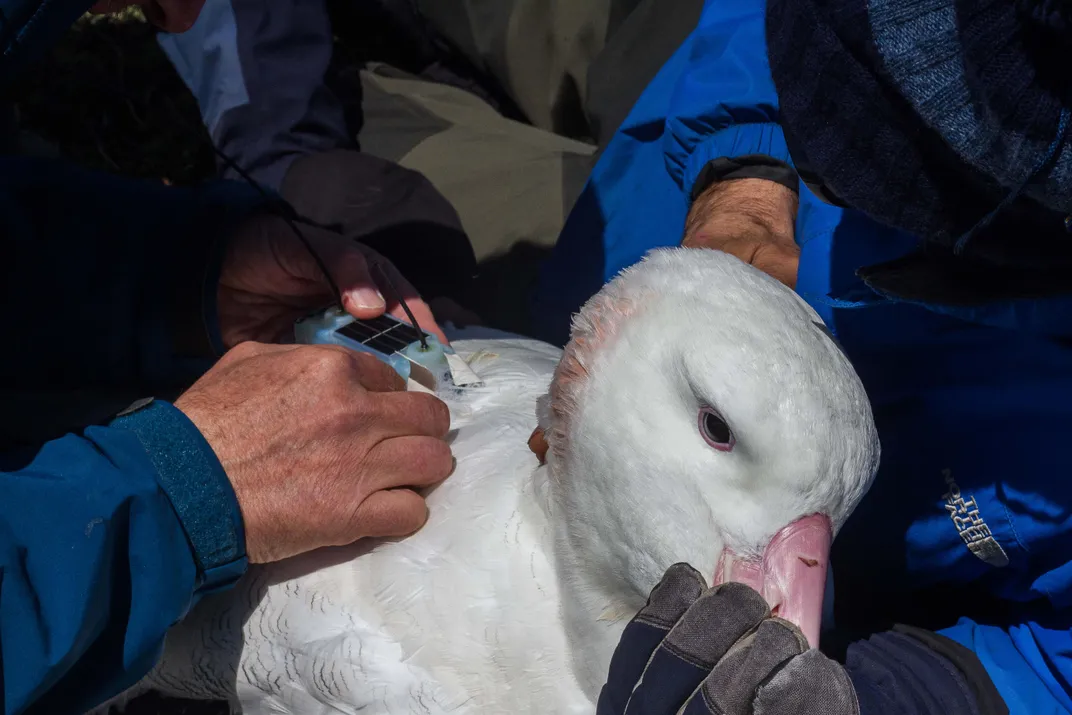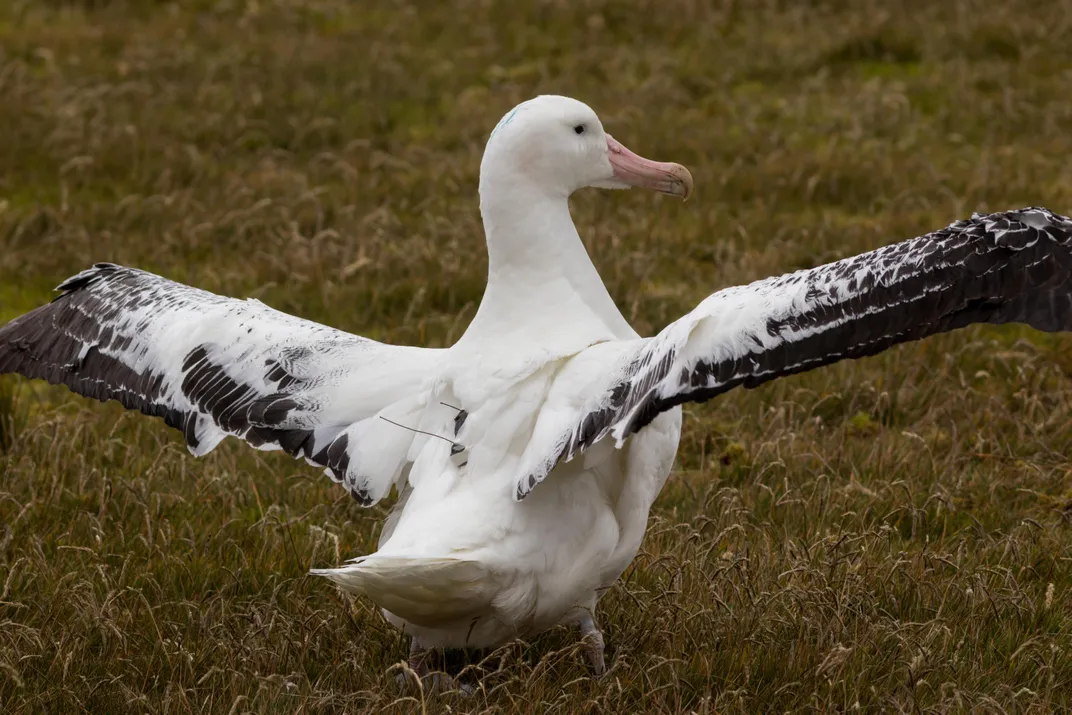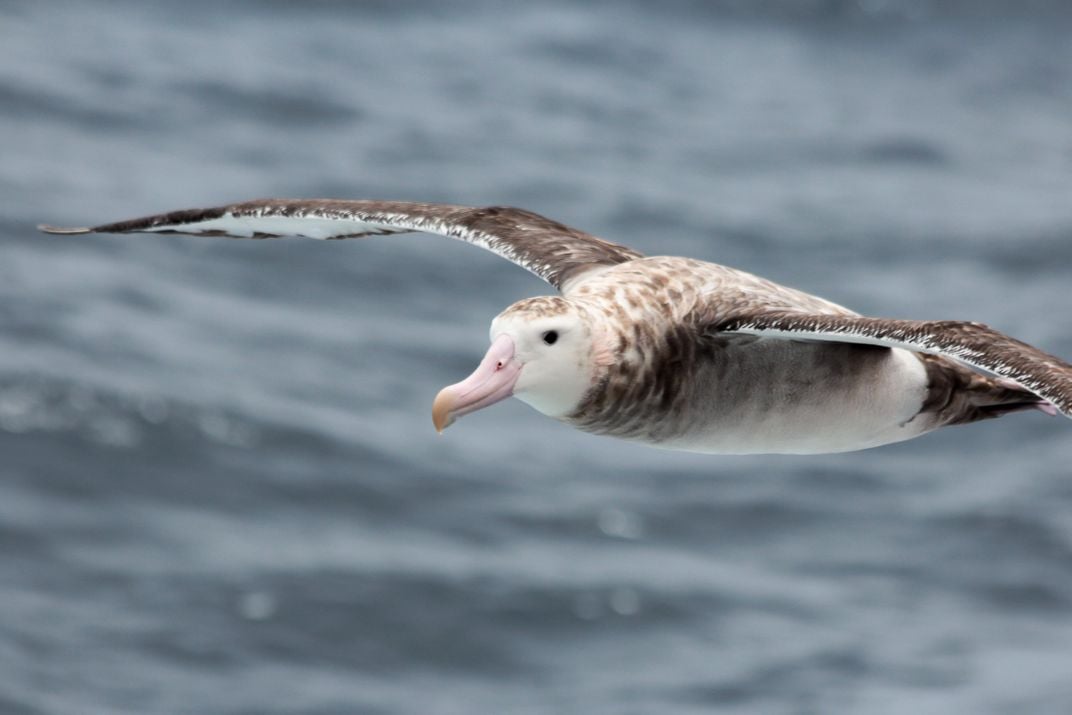Albatrosses Outfitted With GPS Trackers Detect Illegal Fishing Vessels
By utilizing the majestic birds to monitor huge swaths of the sea, law enforcement and conservationists could keep better tabs on illicit activities
/https://tf-cmsv2-smithsonianmag-media.s3.amazonaws.com/filer/95/a9/95a985a0-4e4e-43a7-8603-66a58a25eb36/222275.jpg)
No creature knows the sea quite like the albatross.
Boasting wingspans of up to 11 feet—the largest of any bird alive today—these feathered goliaths, native to the Southern Ocean and North Pacific, are built to soar. Gliding at speeds that often exceed 50 miles per hour, they can cover vast swaths of the sea in minutes, all the while scouring the water for bright flickers of fish. Some species are known to spend years at sea without touching down on land, and a few have even been documented circumnavigating the globe.
With their keen eyes and wandering ways, albatrosses are, in a way, the de facto “sentinels of the sea,” says Henri Weimerskirch, a marine ornithologist at the French National Center for Scientific Research.
Weimerskirch is working to make that title a little more official—by recruiting the seabirds to patrol the ocean for illegal fishing vessels. He and his colleagues have outfitted nearly 200 albatrosses with tiny GPS trackers that detect radar emissions from suspicious ships, allowing the birds to transmit the locations of fishers in the midst of illicit acts. The results of the tracking method were published today in a study in the Proceedings of the National Academy of Sciences.

Capable of following fishing boats into remote regions out of reach of monitoring machines like ships, aircraft and even certain satellites, these feathered crimefighters could offer a convenient and cost-effective way to keep tabs on foul play at sea—and may even help gather crucial conservation data along the way.
“This is a really clever method for facilitating law enforcement,” says Melinda Conners, a conservation biologist studying albatrosses at Stony Brook University who wasn’t involved in the study. “There’s no boat or plane that can match the capability of an albatross to cover these vast oceanic regions.”
In many parts of the world, trawling for a marine catch has become something of a fishy business. Though estimates vary, around a fifth of the fish on the market may be the result of illegal, unreported and unregulated catches at sea. Fishers who trawl without a license, exceed quotas or underreport their hauls imperil fragile ecosystems, and their operations have been linked to other crimes, including human trafficking. All told, illicit fishing is thought to cost the global economy up to $20 billion or $30 billion every year—figures that exceed the annual gross domestic product of about half the world’s countries.
But policing the ocean, which blankets more than 70 percent of our planet, is no easy task for land-based law enforcement agencies. Resources and infrastructure are particularly lacking far from the coast, where regulated strips of ocean give way to international waters, says Amanda Gladics, a fisheries expert at Oregon State University who wasn’t involved in the study.
Out here, surveillance often relies on something of an honor system, wherein vessels voluntarily report their presence through an automatic identification system (AIS) that can easily be switched off. “If any boats cuts off its AIS, nobody knows where the boat is,” Weimerskirch says.
But metaphorically flying under the radar doesn’t preclude a vessel from emitting radar, which ships have to do regularly to navigate and avoid collisions. The range of these signals isn’t big enough to be reliably picked up by stations on shore, keeping the ships’ movements mostly discreet. Radar can be detected within a few miles of the vessel itself, however—as long as something, or someone, can get close enough.

The team’s winged recruits may be poised to fill this monitoring gap. On top of their stamina and moxie, albatrosses also have a certain fondness for fish-toting vessels, says study author Samantha Patrick, a marine biologist at the University of Liverpool. To the birds, the fishing gear attached to these boats is basically a smorgasbord of snacks—and albatrosses can spot the ships from almost 20 miles away.
To test the birds’ patrolling potential, the researchers stomped into the marshy nesting grounds of wandering albatrosses (Diomedea exulans) and Amsterdam albatrosses (Diomedea amsterdamensis) roosting on Crozet, Kerguelen and Amsterdam, three remote island locales in the southern Indian Ocean. After selecting 169 individuals of different ages, the team taped or glued transceivers, each weighing just two ounces, to the birds’ backs and bid them adieu.
Over the course of six months, the team’s army of albatrosses surveyed over 20 million square miles of sea. Whenever the birds came within three or so miles of a boat, their trackers logged its coordinates, then beamed them via satellite to an online database that officials could access and cross-check with AIS data. Of the 353 fishing vessels detected, a whopping 28 percent had their AIS switched off—a finding that caught Weimerskirch totally off guard. “No one thought it would be so high,” he says.
The number of covert ships was especially high in international waters, where about 37 percent of vessels operated AIS-free. Closer to the shore, in regions where individual countries have exclusive economic rights, things were more variable: While all the fish-laden boats detected around the Australian territory of Heard Island kept their AIS on, none of those lurking off the shores of South Africa’s Prince Edward Islands did. These differences seem to reflect how regularly coastal states survey their shores, Weimerskirch says.
Because the birds and their transceivers detected only radar, no identifying information was logged. The task of verifying a boat’s legal status still falls to officials, who must then decide whether to take action, Patrick explains. But in mapping potential hotspots of illegal fishing, the birds set off a chain reaction that could help bring perpetrators to justice.

Compared to expensive, high-tech methods like plane patrols or satellite surveys, the tagged birds seem a sound economic choice, Weimerskirch says. But he acknowledges the possibility that the team’s technique may come with other costs to the albatrosses themselves.
Of the 22 species of albatross species that roam the world’s waters, eight are endangered or critically endangered, including the Amsterdam albatross. Some of the most concerning threats to their existence are the very fishing boats they chase—especially longline vessels that can snare birds on hooks and drag them to a torturous death by drowning. Weimerskirch suspects that at least a couple of the albatrosses the team deployed fell prey to such ships.
In extreme cases, unsanctioned fishers might even try to harm or incapacitate radar-tracking albatrosses to keep their boats’ whereabouts under wraps. “This has to be framed carefully,” Gladics says. “Otherwise … you risk setting up animosity.”
But Weimerskirch, who has spent years documenting the birds’ behavior, points out that most albatrosses surveil vessels from hundreds or thousands of feet away, a distance that makes the trackers essentially impossible to spot. His team’s experiments are also unlikely to put additional birds in harm’s way: Their devices don’t change the birds’ natural routes, and can be easily removed by researchers, or naturally fall off during molting.
What’s more, the data the albatrosses collect could inform policies that prevent unwanted encounters between ships and seabirds. During the trials, the researchers noticed that, compared to juveniles, adults approached vessels more frequently and lingered for longer. The young birds’ hesitancy suggests that their attraction to the ships is learned over time, Patrick says.
Simply knowing where these birds go on their long treks makes for crucial intel as well. In regularly logging their coordinates, the albatrosses are “participating in their own conservation,” Conners says.
To expand their coverage over oceans where albatrosses don’t normally go, the team plans to bring other large, globetrotting species into the mix. Perhaps all the world’s waters will someday be monitored—at least, from a bird’s eye view.
For now, these early findings show that “there exists a very powerful tool to help identify illegal fishing in some of the most remote places on Earth,” Conners says. “That in itself is a huge win for conservation on the high seas.”
/https://tf-cmsv2-smithsonianmag-media.s3.amazonaws.com/accounts/headshot/10172852_10152012979290896_320129237_n.jpg)
/https://tf-cmsv2-smithsonianmag-media.s3.amazonaws.com/accounts/headshot/10172852_10152012979290896_320129237_n.jpg)